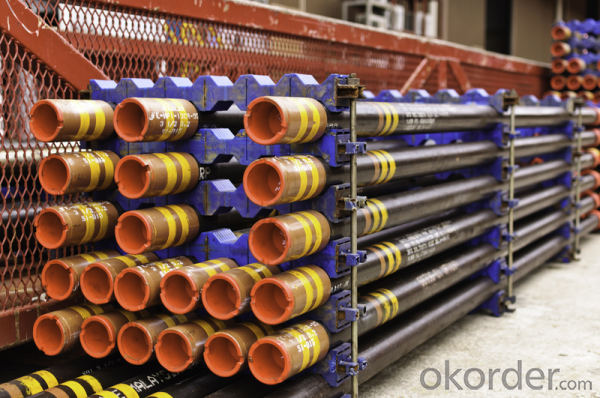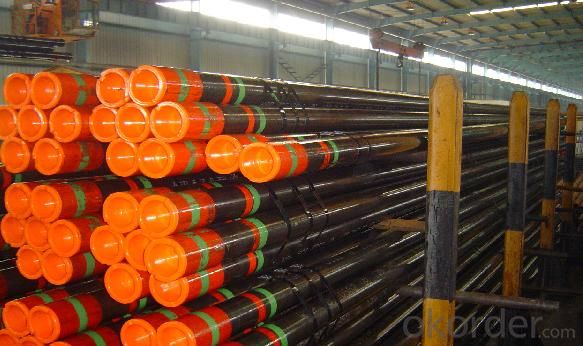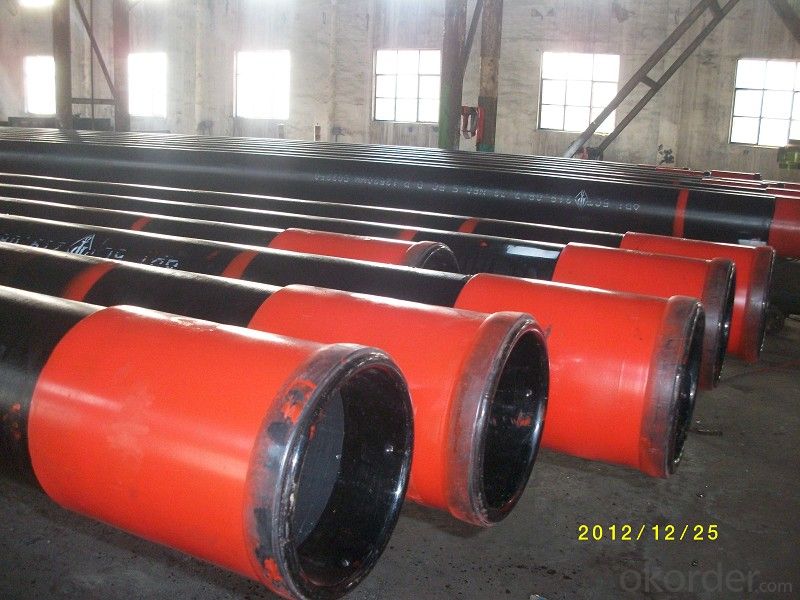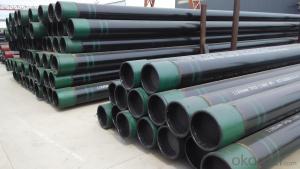API Standard Oil and Gas Well Casing Tube K55
- Loading Port:
- Tianjin
- Payment Terms:
- TT OR LC
- Min Order Qty:
- 1000 m.t.
- Supply Capability:
- 20000 m.t./month
OKorder Service Pledge
OKorder Financial Service
You Might Also Like
Item specifice
casing pipe for oilfield
API 5CT Q125 Casing Pipe|Olifield Casing Pipe
roduct: API 5CT oil casing pipe
Grade: Q125-1,Q125-2,Q125-3,Q125-4.
H40.J55.K55.N80.C75.L80.C90.T95.P110.
OD: 114.3mm to 508mm
Wall thickness: 5.12mm to 16.13mm
Length: R1(4.86-7.62M). R2(7.62-10.36M). R3(10.36-13Meters)
Thread: STC.BTC.LTC
Standard: API 5CT
Technical: Hot Rolled
Type: Seamless alloy API pipe
Surface treatment: blank oil painting+green/red/white/brown painting
Packing: Coating and steel thread protector,3tons in a bundle packed by steel strip
Third party inspection: BV|SGS|TUV
Usage: oil pipeline, oil natural gas, industrial gas, water transportation
Certificate:
API 5CT,Russian Certificate,ISO,CCS




Inspection
Physical properties are checked and each length hydrostatically tested, normally to only 3,000 psi in the plain end (unthreaded) condition. The following are also checked:
Dimensions
Weights
Straightness
Lengths
Part of this inspection is to drift all lengths.
Despite all the American Petroleum Institute (API) specifications and testing, some tubing defects are still found after delivery; thus, some operators do further inspection.
Inspection Method
Size and surface inspection
NDT and pressure test and third party certication
Hydrostatic
Drifting test
Physical and chemicail analysis
Hardness and pressure test.
Electromagnetic
Magnetic particle
Ultrasonic
Out Diameter weight Grade Thread Length in mm kg/m lb/ft 4-1/2" 114.3 14.14-22.47 9.5-15.10 Q125-1,Q125-2,Q125-3,Q125-4 STC/LTC/BTC/XC R1/R2/R3 5" 127 17.11-35.86 11.5-24.10 Q125-1,Q125-2,Q125-3,Q125-4 STC/LTC/BTC/XC R1/R2/R3 5-1/2" 139.7 20.83-61.14 14-22.22 Q125-1,Q125-2,Q125-3,Q125-4 STC/LTC/BTC/XC R1/R2/R3 6 5/8" 168.28 29.76-47.62 20-32 Q125-1,Q125-2,Q125-3,Q125-4 STC/LTC/BTC/XC R1/R2/R3 7" 177.8 25.3-84.97 17.00-57.10 Q125-1,Q125-2,Q125-3,Q125-4 STC/LTC/BTC/XC R1/R2/R3 7-5/8" 193.68 35.72-82.3 24.00-55.30 Q125-1,Q125-2,Q125-3,Q125-4 STC/LTC/BTC/XC R1/R2/R3 8-5/8" 219.08 35.72-72.92 24.00-49.00 Q125-1,Q125-2,Q125-3,Q125-4 STC/LTC/BTC/XC R1/R2/R3 9-5/8" 244.48 48-112.50 32.30-75.62 Q125-1,Q125-2,Q125-3,Q125-4 STC/LTC/BTC/XC R1/R2/R3 10-3/4" 273.05 48-127 32.75-85.30 Q125-1,Q125-2,Q125-3,Q125-4 STC/LTC/BTC/XC R1/R2/R3 11-3/4" 298.45 62.50-105 42.00-71.00 Q125-1,Q125-2,Q125-3,Q125-4 STC/LTC/BTC/XC R1/R2/R3 13-3/4" 339.72 71.43-107.15 48.00-72.00 Q125-1,Q125-2,Q125-3,Q125-4 STC/LTC/BTC/XC R1/R2/R3 16" 406.40 96.73-162.21 65.00-109.0 Q125-1,Q125-2,Q125-3,Q125-4 STC/LTC/BTC/XC R1/R2/R3 18-5/8" 473.08 130.21 87.50 Q125-1,Q125-2,Q125-3,Q125-4 STC/LTC/BTC/XC R1/R2/R3 20" 508.00 139.89-197.9 94.00-133.00 Q125-1,Q125-2,Q125-3,Q125-4 STC/LTC/BTC/XC R1/R2/R3 Remarks: 1 R1: 4.86M-7.62M R2: 7.62M-1036M R3:10.36M-12M 2 Standard: API 5CT 3 Grade: H40/J55/K55/N80/C75/L80/C90/T95/P110/Q125 Our service:
1): Durable, strict quality management and control, production follow the ISO.
2): Advanced precision casing pipe equipment to guarantee prime quality.
3): Casing pipe with smooth surface. No defects. Continuous skill improvements.
4): Short delivery, competitive good offer. Casing pipe MOQ is low.
5): Third party Inspection for casing pipe can be TUV/SGS/BV6): Company design team always think how develop new skill and new products to meet requirements of markets.
7): Good service, IF customers have any problem during application, we will surely try our best to solve them.
8): Regular thread is STC/LTC/BTC or as client's requirement.9): Surface treatment can be painted, or based on the requirements of customers.
- Q:Can steel pipes be used in extreme weather conditions?
- Steel pipes are suitable for use in extreme weather conditions because they are known for their high strength and durability. This makes them applicable in construction, infrastructure, and transportation. Steel pipes are commonly used to transport fluids and gases across industries and are specifically designed to withstand harsh environmental conditions such as extreme temperatures, high pressures, and corrosive environments. Even in extreme weather conditions like intense heat, cold, or heavy rain, steel pipes can maintain their structural integrity and functionality. Moreover, they can be coated or insulated to provide extra protection against corrosion and maintain desired temperatures. In conclusion, steel pipes are a dependable option for extreme weather conditions due to their strength, durability, and ability to resist various environmental factors.
- Q:What is the maximum pressure that steel pipes can handle?
- The maximum pressure that steel pipes can handle depends on various factors such as the grade and thickness of the steel, the diameter of the pipe, and the intended application. However, steel pipes are known for their high strength and durability, allowing them to withstand high pressure conditions. In general, steel pipes can handle pressures ranging from a few hundred PSI (pounds per square inch) to several thousand PSI, depending on the specific specifications and design considerations. It is crucial to consult engineering standards, industry guidelines, and relevant experts to determine the appropriate maximum pressure for a specific steel pipe.
- Q:How are steel pipes used in sewage treatment plants?
- Steel pipes are commonly used in sewage treatment plants to transport wastewater, sludge, and other fluids throughout the facility. They provide a durable and corrosion-resistant solution for the harsh environments found in these plants. Steel pipes are used for various purposes, such as conveying raw sewage, distributing treated water, and carrying sludge for disposal or further processing.
- Q:How are steel pipes used in the construction of railways and transportation systems?
- Steel pipes are used in the construction of railways and transportation systems primarily for their durability and strength. They are utilized for various purposes such as the fabrication of tracks, bridges, tunnels, and support structures. Steel pipes provide a reliable and long-lasting solution for the transportation industry, ensuring the safety and efficiency of railway systems.
- Q:What are the different types of couplings used with steel pipes?
- There are several types of couplings used with steel pipes, including threaded couplings, slip-on couplings, compression couplings, and grooved couplings.
- Q:How are steel pipes used in the manufacturing of machinery and equipment?
- The manufacturing of machinery and equipment heavily relies on the widespread utilization of steel pipes, thanks to their numerous advantageous properties. These pipes serve as a primary means of conveying different materials, fluids, and gases within the machinery, effectively ensuring safe and efficient transportation. One crucial application of steel pipes in machinery manufacturing lies in the realm of hydraulic and pneumatic systems. Hydraulic systems depend on steel pipes to transmit power and regulate fluid flow, while pneumatic systems utilize these pipes to transport compressed air, powering various components. The strength and durability inherent in steel pipes guarantee their ability to withstand the immense pressure and forces exerted by these systems, making them a dependable choice for such purposes. Moreover, steel pipes find extensive use in the construction of machinery frames and structures. Their exceptional tensile strength and resistance to corrosion make them an ideal option for providing structural support and stability to heavy machinery. These pipes can be effortlessly welded, bent, and fabricated into diverse shapes, allowing for flexibility in design and enabling the creation of intricate machinery structures. Furthermore, steel pipes play an indispensable role in the transportation of raw materials and finished products throughout the manufacturing process. They frequently serve as conduits for the movement of liquids, gases, and granular materials, ensuring the smooth operation of machinery and equipment. Steel pipes are particularly well-suited for handling abrasive and corrosive materials, as their robust construction guarantees minimal wear and tear over time. In conclusion, the extensive utilization of steel pipes in the manufacturing of machinery and equipment stems from their strength, durability, and versatility. Whether it be for hydraulic systems, structural support, or material transportation, steel pipes form an integral component that significantly contributes to the efficiency and dependability of machinery across various industries.
- Q:What are the different types of steel pipe coatings for corrosive environments?
- There are several types of steel pipe coatings that are commonly used for corrosive environments. These include fusion bonded epoxy (FBE) coating, three-layer polyethylene (3LPE) coating, three-layer polypropylene (3LPP) coating, and coal tar enamel (CTE) coating. FBE coating provides excellent corrosion resistance and is commonly used for underground pipelines. 3LPE and 3LPP coatings combine a layer of epoxy, an adhesive layer, and a polyethylene or polypropylene outer layer, offering superior protection against corrosion and mechanical damage. CTE coating, although less common nowadays, is still used for certain applications due to its resistance to water and chemical corrosion.
- Q:What is the average lifespan of steel pipes?
- The average lifespan of steel pipes can vary depending on various factors such as the quality of the steel used, the environment in which they are installed, and the maintenance and care they receive. However, on average, well-maintained steel pipes can last anywhere from 50 to 100 years or more.
- Q:How do steel pipes compare to ductile iron pipes?
- Steel pipes and ductile iron pipes have some similarities, such as being durable and strong materials for piping systems. However, there are a few key differences between the two. Steel pipes are typically lighter and more flexible, making them easier to handle and install. They also have a higher resistance to corrosion and can withstand higher pressure and temperature conditions. On the other hand, ductile iron pipes have a higher tensile strength and are more resistant to impact and vibration. Overall, the choice between steel and ductile iron pipes depends on specific project requirements, such as the intended application, location, and budget constraints.
- Q:What are the advantages of using steel pipes in the manufacturing industry?
- There are several advantages of using steel pipes in the manufacturing industry. Firstly, steel pipes are known for their high strength and durability, making them ideal for carrying heavy loads and withstanding harsh conditions. Secondly, steel pipes have excellent resistance to corrosion, reducing the risk of leaks and ensuring a longer lifespan. Additionally, steel pipes offer a wide range of sizes and shapes, allowing for flexibility in design and easy customization. Furthermore, steel pipes are cost-effective compared to other materials, as they require minimal maintenance and have a low risk of failure. Lastly, steel pipes are environmentally friendly, as they are fully recyclable and contribute to reducing carbon emissions during manufacturing. Overall, the advantages of using steel pipes in the manufacturing industry make them a reliable and efficient choice for various applications.
1. Manufacturer Overview |
|
|---|---|
| Location | |
| Year Established | |
| Annual Output Value | |
| Main Markets | |
| Company Certifications | |
2. Manufacturer Certificates |
|
|---|---|
| a) Certification Name | |
| Range | |
| Reference | |
| Validity Period | |
3. Manufacturer Capability |
|
|---|---|
| a)Trade Capacity | |
| Nearest Port | |
| Export Percentage | |
| No.of Employees in Trade Department | |
| Language Spoken: | |
| b)Factory Information | |
| Factory Size: | |
| No. of Production Lines | |
| Contract Manufacturing | |
| Product Price Range | |
Send your message to us
API Standard Oil and Gas Well Casing Tube K55
- Loading Port:
- Tianjin
- Payment Terms:
- TT OR LC
- Min Order Qty:
- 1000 m.t.
- Supply Capability:
- 20000 m.t./month
OKorder Service Pledge
OKorder Financial Service
Similar products
New products
Hot products
Related keywords































